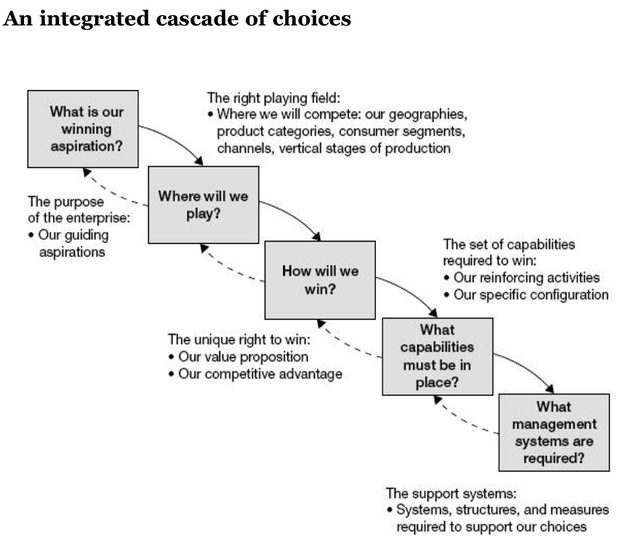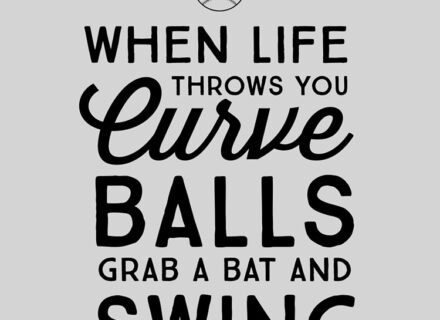I often hear people in business, at all levels, say they want to be more strategic or they want to ‘play a more strategic role’. Heck, I am one of those people. I also notice that the understanding or subjective definition of what strategy means varies widely. Worse yet, if you Google ‘What is strategy’ you get 3.6 billion results. That’s billion, with a B!
Nonetheless, one of the best descriptions of strategy I’ve come across, in layman’s terms, was this:
“Strategy is about making specific and deliberate choices to improve your odds of achieving your objective”. ~A.G. Lafley & Roger Martin – Playing to Win (paraphrased with a personal addition)
I’ll unpack that, but let’s first look at what strategy is not.
Strategy is not:
- Bold statements about the future (mission or vision statements)
- Vague descriptions about your desired end-of-year goals.
- Silo’d operating plans, or operating plans in general
- Forecasts
- General goals
- BHAGs (Big Hairy Audacious Goals)
- Best practices
- Turn-by-turn directions (tactics)
If we agree that strategy is not any of the points above, then let’s move on to what it is, and some of the key aspects and elements of a strategy. One important idea to keep in mind throughout this post is that Strategy is Choice. Deliberately doing X instead of Y because it improves your odds of achieving your objective. Understanding how odds/probabilities factor into strategy is also important. More on that later.
Richard Rumelt, a king in the field of top strategic thinkers says there are effectively three elements to good strategy. He groups them into an essential logical structure which he refers to as the kernel. That is, the kernel of strategy.
Those elements are: a diagnosis, a guiding policy, and coherent actions. Simply put, the diagnoses defines and explains the nature of the challenge. The guiding policy provides a general, overall approach chosen to overcome the obstacles identified in the diagnoses. Coherent actions are the steps coordinated with the necessary resources to meet the objective. Although the word ‘choice’ is absent from these three elements, it’s certainly part of Rumelt’s views on strategy. You could underscore guiding policy and coherent actions with the notion of choice embedded.
“The kernel of strategy includes a diagnoses, guiding policy, and coherent actions.” ~Richard Rumelt
From experience, I can say the element that is most overlooked, or given the least attention is the upfront diagnoses. That is, to intimately understand the cards you’re playing with so to ensure the best choices are made to improve your odds of success. Generally, we lean too heavily on assumptions without verification or run similar playbooks from prior years, with small modifications or ‘enhancements’ that are intended to optimize what we’ve always done. Diving deep into data, getting inputs from internal and external stakeholders, piling through industry research and more. These are all ways to get closer to verifying the assumptions that will start to shape your guiding policies and, later, the coherent actions that bring your strategy to life.
In ‘Strategy Beyond The Hockey Stick’, written by a few McKinsey Partners, they emphasize the use of deep, testable data in the diagnoses phase of strategy development. To some, this may sound obvious, but to far more it’s overlooked or worse yet, ignored.
Three Big Strategy Levers
I really enjoyed the fresh take on strategy in ‘Strategy Beyond The Hockey Stick’ because it was so incredibly data driven. I’d expect nothing less from McKinsey. They talk about the 10 variables that make a difference, and those variables are bucketed into three important categories. Endowment, Trends, and Moves. Coupled with Rumelt’s kernel of strategy, you’re able to more clearly navigate the strategic process.
- Endowment: The book describes endowment as revenue size, debt level, and investment in R&D. I.e., how big are you, how much leverage do you have, and how much are you investing in innovation?
- Trends: This encompasses industry trends and geographic trends. Factor in tailwinds AND headwinds.
- Moves: Pointing back to our coherent actions from earlier, your moves need to be thought of as the big moves you need to make to improve your odds of success. Examples at the corporate level include programmatic M&A, dynamic allocation of resources, strong capital expenditures, strength in productivity programs, and improved differentiation.
If you were to translate these levers down to a departmental level, it would look something like this:
- Endowment= Resources available or needed. Size of your team, opex budget, skills/talents, etc.
- Trends= Industry, competitive, functional area trends (i.e., what’s happening in digital marketing trends).
- Moves= The big plays you need to execute. The plays that will give your team the best odds in supporting the bigger corporate goals. Tap into your true source of competitive advantage here.
Peanut Butter-ing
The enemy of great strategy is the peanut butter approach. Simply put, this is spreading your resources thinly across many opportunities, choices, and activities. To avoid peanut butter-ing your resources, you need to think in bets. If I have a $1M OpEx budget, I can either spread that across a number of opportunities or I can make a handful of bigger bets with those same resources. You can probably guess which route is more effective. The key, of course, is making the right bets and allocating resources wisely to out-compete the competition.
Conclusion: Peanut butter is great for sandwiches and cookies, but not strategy.
Integration of Your Choices
Bringing it all back to the idea that Strategy is Choice, former Chairman and CEO of Proctor and Gamble thinks of these choices in a visual cascade (shown below).
Credit: ‘Playing to Win’, by A.G. Lafley and Roger L. Martin.
Since we have already covered most of the elements in the cascade throughout this post, I’ll end on the topic of systems and structures (the last elements of the cascade). More specifically, a focus on incentives and measures. All too often we get all the way to the end of the strategic process without clearly articulating how we are going to incentivize the behaviors that will mobilize your strategy on the playing field. In other words, if we need the sales team to execute specific activities or behaviors, do we have the right incentives and actively tracked measures in place to make sure that happens with as little friction as possible.
If your strategy intends to have the sales force go in one direction but the current incentive structure has them going the opposite direction, good luck on making it work. Think of incentives as a Key Factor of Success (KFS), as described by Kenichi Ohmae in ‘The Mind of the Strategist’.
Strategy is hard work but does not need to be complex.
Strategy is hard work but it does not need to be complex. While there are 3.6 billion results for ‘what is strategy’ in a Google search, synthesizing them all down to their essence is likely to produce very similar elements that, combined, provide your blueprint for strategy building success.
Have a different view of what strategy means, I’d love to hear it. I write primarily to learn and cement ideas and concepts in my mind. If it’s also helpful to you, that’s even better.




